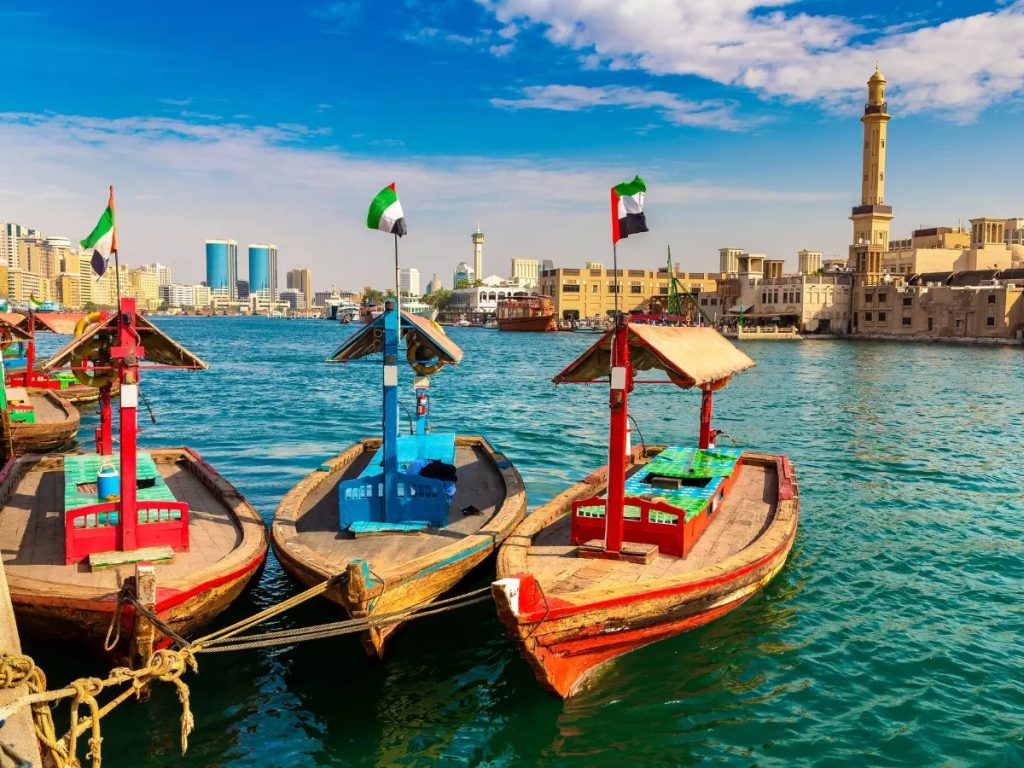Did you know Dubai Creek was once the lifeline of the city’s pearl diving and trading economy, long before skyscrapers dominated the skyline? Today, it offers a perfect blend of old-world charm and modern attractions.
Understanding Dubai Creek’s Layout
Dubai Creek divides the city into two main areas: Deira on the northern side and Bur Dubai to the south. The creek stretches about 14 kilometers inland, creating a natural harbor that’s been crucial to Dubai’s development since the 19th century. Most tourist activities center around the area between the Al Maktoum and Al Garhoud bridges, where you’ll find the iconic abras (water taxis) crossing the waterway every few minutes.
The best way to navigate is to think of the creek as having three distinct zones: the historic souks near the Old Dubai area, the modern developments around the Dubai Creek Harbour, and the peaceful Al Seef district that blends both worlds. Each offers unique experiences, so we’ll help you plan your time wisely between them.
Best Time to Visit Dubai Creek
Timing your visit can make all the difference in your experience. The cooler months from November to March offer pleasant temperatures around 25°C (77°F), perfect for strolling along the waterfront. Mornings between 9-11 AM are ideal for souk shopping before crowds arrive, while sunset (around 5:30-6:30 PM depending on season) provides magical golden hour views perfect for photography.
Avoid Friday mornings when some attractions may have limited hours due to the Islamic weekend. During Ramadan, the area comes alive at night with special cultural events, but dining options may be limited until sunset. The Dubai Shopping Festival (December-January) brings extra sparkle to the creek area with light displays and special performances.
Essential Safety Tips for Visitors
While Dubai Creek is generally safe, a few precautions will ensure worry-free exploration. The stone walkways near the souks can be uneven, so wear comfortable shoes with good grip. When crossing busy roads near the spice and gold souks, use designated pedestrian crossings – Dubai drivers aren’t always attentive to jaywalkers.
Keep valuables secure in crowded areas, though violent crime is extremely rare. The Dubai Police app (available in English) can be useful for emergencies. Taxis are plentiful, but always ensure they’re metered or use Careem/RTA apps. For abra rides, hold onto hats and phones – the breeze can be stronger than expected!
Must-Visit Attractions Around Dubai Creek
Start your journey at the Dubai Museum in Al Fahidi Fort, the city’s oldest existing building dating to 1787. Its air-conditioned galleries provide welcome relief from the heat while showcasing Dubai’s remarkable transformation. Just outside, the Al Fahidi Historical Neighborhood’s wind-tower architecture offers perfect photo backdrops.
The Gold Souk dazzles with intricate jewelry displays, while the nearby Spice Souk engages all senses with colorful mounds of saffron, frankincense, and dried limes. Don’t miss the Textile Souk for beautiful fabrics where bargaining is expected – start at about 40% of the initial price quoted.
For modern contrast, the Dubai Creek Harbour development offers stunning views of the Dubai Creek Tower (future tallest structure in the world) and the Ras Al Khor Wildlife Sanctuary, where you can spot flamingos from October to April.

Cultural Experiences Not to Miss
An abra ride across the creek (just 1 AED) is perhaps Dubai’s best-value tourist experience. For something more luxurious, book a dinner cruise on a traditional dhow – many include cultural performances. The Sheikh Mohammed Centre for Cultural Understanding offers insightful heritage tours and Q&A sessions about Emirati traditions.
Time your visit to see the Al Seef district’s heritage shows on weekends, or join a Friday morning yoga session by the water. The Coffee Museum in Al Fahidi offers tastings of different Arabic coffee styles, while the Coin Museum showcases rare currencies from Dubai’s trading history.
Dining Options for Every Taste
For authentic Emirati cuisine, Al Fanar Restaurant in Al Seef serves classics like machboos (spiced rice with meat) in a retro 1960s setting. Arabian Tea House offers over 150 tea varieties in a picturesque courtyard. Craving something more modern? QD’s at Dubai Creek Golf Club combines shisha lounging with stunning skyline views.
Budget travelers will love the cafeteria-style Automatic Restaurant for cheap, delicious shawarma, while seafood enthusiasts should try the fresh catches at Bu Qtair, a no-frills local favorite. Remember that many smaller eateries may close between 3-6 PM and reopen for dinner.
Getting Around the Creek Area
The Dubai Metro’s Green Line serves the area with Al Ras and Al Ghubaiba stations placing you right near the souks. Water buses (starting at 5 AED) offer scenic routes along the creek with stops at key attractions. Taxis are abundant, but walking between nearby sights is often fastest – just carry water and sun protection.
For a unique perspective, rent a kayak from the Dubai International Marine Club and paddle past historic sites. The Dubai Ferry provides affordable sightseeing cruises departing from Al Ghubaiba Marine Station. If driving, note that parking near the souks is limited – the Al Seef parking garage is your best bet.
Special Considerations for Different Travelers
Families with kids will appreciate the Children’s City museum and the open spaces of Al Seef for little ones to run around. Many creek-area hotels like the Park Hyatt have excellent kids’ clubs. Seniors or those with mobility issues should focus on Al Seef’s smooth walkways and consider private abra hires rather than crowded public ones.
Photography enthusiasts should seek out the Bastakia Quarter’s narrow lanes in morning light and return for night shots of illuminated dhows. Instagram hotspots include the “Dubai” sign at Al Seef and the rainbow-colored textile souk stalls.
Day Trip Itinerary Suggestions
For first-timers, we recommend this full-day plan: Start at the Dubai Museum, wander Al Fahidi’s alleys, cross to Deira by abra for souk shopping, lunch at Al Fanar, then take a water bus to Al Seef for sunset. End with a dhow dinner cruise.
Half-day visitors should prioritize the abra crossing and gold/spice souks, plus quick stops at the Coffee Museum and Textile Souk. Those with multiple days can add the Heritage Village, Sheikh Saeed Al Maktoum House, and deeper exploration of Al Seef’s galleries and cafes.
Seasonal Events Worth Planning Around
The Dubai Heritage Week (October) brings traditional performances and craft demonstrations to the creek area. During Eid celebrations, the souks stay open late with special decorations and sweets. The Dubai International Boat Show (March) transforms the marina into a floating showcase of luxury yachts.
Winter months see pleasant temperatures for the Al Seef Market nights featuring local artisans. If visiting in summer, schedule indoor attractions like museums for midday and save outdoor exploring for early mornings when temperatures are more manageable.
Essential Arabic Phrases for the Creek Area
While English is widely spoken, knowing a few Arabic phrases enhances the experience: “Kam al-thaman?” (How much is this?) helps in souks. “Shukran” (Thank you) goes a long way. “Mafi mushkila” (No problem) shows cultural awareness when bargaining. “Yalla” means “Let’s go” – you’ll hear it often on abras!
Nearby Attractions to Combine with Your Visit
Extend your exploration to the Dubai Frame (15-minute taxi away) for panoramic views connecting old and new Dubai. The Etihad Museum tells the UAE’s formation story through interactive exhibits. For shopping, the Wafi Mall combines Pharaonic-themed architecture with luxury brands.
Final Practical Tips
ATMs are plentiful, but smaller souk vendors prefer cash (especially for bargaining). Dress modestly in crowded areas – shoulders and knees covered shows respect. Free public restrooms are available at Al Seef and major souk areas. Download the “Dubai Creek” map on Google Maps for offline use as some alleyways can be confusing.
As the www.few.ae editorial team, we’ve crafted this guide to help you experience Dubai Creek’s magic safely and memorably. Whether you’re a history buff, photography enthusiast, or simply seeking authentic Emirati culture, this historic waterway offers something for every traveler.
Bonus Local Insight
For the most atmospheric experience, visit the creek twice – once during daylight to appreciate the bustling commerce, and again after dark when the dhows’ lights reflect magically on the water. This contrast perfectly captures Dubai’s dual identity as both traditional trading hub and modern metropolis.


 then "Add to Home Screen"
then "Add to Home Screen"